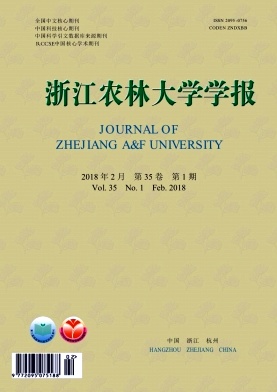-
植物中的Shaker家族是迄今为止研究最深入的钾转运家族之一,被认为在植物钾离子(K+)吸收以及转运方面起到至关重要的作用[1-2]。最早报道的拟南芥Arabidopsis thaliana内向整流K+通道AKT1属于Shaker家族,它具有双亲和钾吸收特性,主要在拟南芥根部表皮细胞和皮层细胞中表达,在拟南芥吸收K+过程中起到关键作用。随后已陆续从其他植物中克隆得到该基因,均表现出明显的组织特异性表达,如OsAKTl主要在水稻Oryza sativa根中表皮和维管组织中表达[3];ZMK1主要在玉米Zea mays胚芽鞘皮层中表达[4];SeAKT1在盐角草Salicornia europaea成苗的根和冠中均有表达,但在根中表达量略高[5];GkKT2在三叶期棉花Gossypium hirsutum根、茎、叶和顶芽等各部位均有表达,但在叶中表达量较大[6]等。Shaker通道家族也包括外整流K+通道,但目前针对它的研究较少。SKOR与AKT1在跨膜区具有很高的同源性,但C端比AKT1多约200个氨基酸及6个锚蛋白重复基序(ankyrin repeat motif,AR)[7-8]。据报道[9]:胞内K+浓度可以调节SKOR活性,而对K+的感受性就是依赖C端结构域部分感应细胞内外电压差而实现的,AKT1对于细胞内的K+却没有响应。GAYMARD等[10]首次从拟南芥中克隆到编码外整流K+通道的基因SKOR,并发现它在根中柱组织特异表达,且能被脱落酸(ABA)抑制,其介导根细胞中的K+向木质部外流的转运。在玉米根皮层及中柱细胞中也检测到了外整流K+通道,并确定其介导K+从中柱细胞外排到木质部汁液中,外整流K+通道基因的这一功能在大麦Hordeum vulgare中也得到了验证[11-12]。另外,Shaker钾离子通道的孔结构域和蛋白质氨基酸序列上的组氨基酸残基高度保守,这决定了其通道活性在很大程度上受细胞内外酸碱度调节,比如,KAT1活性在细胞膜内外低pH值的情况下被激活[13],SKOR的活性受酸碱度影响较大[14-16]。小白菜Brassica chinensis花粉质膜外整流K+通道受细胞内外pH值的影响,从而影响花粉萌发和花粉管的伸长[17]。黑果枸杞Lycium ruthenicum为茄科Solanaceae枸杞属Lycium多年生野生盐生类灌木,主要生长在中国西北青海、新疆、甘肃等地的荒漠地区,不但具有极强的耐旱、耐盐碱性,还具有重要的经济价值和药用价值,在生态建设和经济发展中有巨大的应用前景,也是研究多年生植物抗逆机制的优良植物材料。已有研究结果表明[18]:与宁夏枸杞Lycium barbarum相比,黑果枸杞具有更强的耐盐能力。在盐分胁迫下,黑果枸杞各器官中钠离子(Na+)和氯离子(Cl-)相对含量均增加,叶片中积累最多,K+/Na+比均下降,在根中比值比地上部分高。但与宁夏枸杞相比,黑果枸杞各器官中的K+含量下降相对较少,积累的Na+和Cl-含量也相对较少,甚至在450 mmol·L-1氯化钠高盐胁迫下,各器官中K+/ Na+比下降的幅度仍小于宁夏枸杞,其中叶片组织中K+/ Na+比值显著高于同浓度胁迫下的宁夏枸杞,但与拟南芥等传统植物相比,黑果枸杞耐盐碱基因尤其是钾吸收相关基因的鉴定未见报道。为进一步深入研究黑果枸杞的耐盐机制,本研究采用反转录聚合酶链式反应(reverse transcription PCR,RT-PCR)方法克隆了黑果枸杞SKOR基因并分析其序列特征,研究了不同pH值的高盐环境对SKOR基因表达丰度的影响,为以后研究外整流K+通道SKOR在黑果枸杞体内能否维系高K+/Na+比,进而在提高植株耐盐性中发挥重要作用而奠定基础。
HTML
-
黑果枸杞种子采自青海省大格勒乡,在北京林业大学林木育种国家工程实验室温室内进行播种培养。具体方法:挑选籽粒饱满的黑果枸杞种子播种在以m(花卉土):m(蛭石):m(珍珠岩)=3:2:1混合后的穴盘中,每天定时喷施无菌水至发芽后,配制Hoagland营养液进行浇灌。温室温度为(23 ± 2)℃, 光照16 h·d-1,空气相对湿度控制在70%左右。以生长4周的黑果枸杞幼苗为实验材料。
-
取4周龄黑果枸杞幼苗的根系,加入液氮研磨至粉末状。根据改进的十六烷基三甲基溴化铵(CTAB)法提取RNA,用琼脂糖凝胶电泳和紫外分光光度计法鉴定其完整性和质量。
-
利用拟南芥等其他植物的SKOR核苷酸序列在实验室前期建立的本地黑果枸杞转录组数据库中进行Blast分析,得到1条长度为2 500 bp左右的拟SKOR基因。根据转录组数据库中的片段利用Primer 5.0软件设计引物P1(5′-ATGCACATTAATAATGGAGGAG-3′)和P2(5′-AGTTGATTCATTGTTCAAGTACAA-3′),由上海生工生物工程技术服务公司合成引物后,用于该黑果枸杞拟SKOR基因序列全长的扩增。
-
采用RT-PCR法进行基因克隆,PCR扩增反应体系:2× PCR Mix 10 μL,上游引物和下游引物各1 μL,cDNA 1 μL,双蒸水7 μL。反应程序为:95 ℃预变性5 min;95 ℃变性30 s,55 ℃退火30 s,72 ℃延伸90 s,40个循环;最后72 ℃延伸10 min,10 ℃保存。PCR产物用体积分数为1.0%的琼脂糖凝胶电泳检测后,按照琼脂糖凝胶DNA回收试剂盒操作说明书进行目的片段的回收和纯化。
-
将回收的PCR产物连接到PMD18-T载体上,转化Top10大肠埃希菌Escherichia coli感受态细胞,在含50 mg·L-1氨苄青霉素的LB固体平板培养基上进行蓝白斑阳性克隆筛选,筛选出的阳性克隆经PCR鉴定后,送至上海生工生物工程技术服务公司测序。所测序列的比对分析在DNAMAN 6.0生物软件上进行,在美国生物技术信息中心(NCBI)网站(www.ncbi.nlm.nih.gov/BLAST)上进行Blast搜索。利用NCBI ORFfinder工具确定基因的开放阅读框。蛋白质亲/疏水性预测用ExPASy网站的在线软件ProtScale分析,以Hphob.Kyte& Doolittle为默认值。进化树分析先使用Clustal X 2.1软件对来自番茄Solanum lycopersicum,马铃薯Solanum tuberosum,胡杨Populus euphratica等物种的SKOR成员进行序列比对,然后使用MEGA 5.1 Beta 3软件用邻接法构建。
-
对4周龄的黑果枸杞苗分别用300 mmol· L-1氯化钠与450 mmol·L-1碳酸氢钠(pH 9.0)处理6 h,利用天根生化科技有限公司Real Master Mix(SYBR Green)PCR试剂盒,采用实时荧光定量PCR(real-time quantitative PCR,qRT-PCR)法,检测LrSKOR基因的相对表达量。扩增目标LrSKOR基因引物设计为LrSKOR-F: 5′-ATGCACATTAATAATGGAGGAG-3′和LrSKOR-R: 5′-AGTTGATTCATTGTTCAAGTACAA-3′;以黑果枸杞延伸因子1α基因EF1α[19]作为内参基因,其引物为EF1αF: 5′-GAAGGGTGTCCCTCAGATCA-3′和EF1α R: 5′-CCGTCC ATGTCGTCTCTTTT-3′,对反转录所得的cDNA按照1,1/10,1/100,1/1 000,1/10 000进行稀释,绘制相对标准曲线。实时荧光定量设置反应程序为:94 ℃ 2 min,94 ℃ 20 s,55 ℃ 30 s,72 ℃ 30 s,设置36个循环,各轮循环第3步进行荧光采集,最后95 ℃变性1 min,退火至55 ℃。根据荧光值,绘制熔点曲线。内参基因的表达与LrSKOR基因按照同样的反应程序同时测试。独立提取3次待测样品的RNA作为生物学重复,设置技术性重复3次·样品-1。
1.1. 试验材料
1.2. 总RNA的提取
1.3. 引物的设计与合成
1.4. RT-PCR扩增
1.5. 阳性克隆的鉴定与序列分析
1.6. 基因表达分析
-
取生长4周的黑果枸杞幼苗根部作为实验材料,提取总RNA,凝胶电泳检测结果显示28 S RNA条带亮度约为18 S RNA的2倍,表明所提取的黑果枸杞总RNA完整性较好。进一步用紫外分光光度计检测得出D(260)/D(280)为2.1,说明所提取的RNA纯度较好,可用于进一步实验。
按照反转录试剂盒操作说明,以总RNA反转录得到第1链cDNA后,以该cDNA为模板,以拟SKOR基因的引物P1和P2进行PCR扩增。扩增产物经凝胶电泳检测发现亮带,且上下无杂带,与预期片段大小一致,推测可能是目的基因。将连接有纯化目的片段的PMD18-T克隆载体转化大肠埃希菌Top10后,从转化的平板上随机挑取6个白色菌斑振摇过夜培养,进行PCR扩增,得到的扩增条带大小与RT-PCR结果一致,表明这些克隆为阳性克隆。
-
将PCR产物进行测序,Genebank登录号为KY563342。测序所得到的SKOR基因序列全长为2 448 bp,包括1个完整的开放阅读框,其编码的SKOR蛋白包含815个氨基酸残基。在NCBI数据库进行Blast序列比对分析结果显示,该基因序列与拟南芥(NM_111153.3),葡萄Vitis vinifera(AJ490336),蓖麻Ricinus communis(XM _002533405)和胡杨(EU382997.1)等植物外整流K+通道基因的核苷酸序列的同源性均在65%以上,其中与葡萄推测的外整流K+通道基因的核苷酸序列的同源性达到70.36%;通过和茄科植物马铃薯(XM_006352418.2),番茄(XM_004250158.3),甜辣椒Capsicum annuum(XM_016696732.1)等比对同源性很高,其中与马铃薯全长同源性最高,达到90.31%,表明本研究已克隆到外整流K+通道基因全长,将其命名为LrSKOR。用ExPASy网站分析该蛋白的理化性质,得到其相对分子量约为9.33×104,理论等电点为6.32,其中数量最丰富的氨基酸依次是亮氨酸(Leu),异亮氨酸(Ile)和丝氨酸(Ser),分别占11.2%,8.6%和7.2%,色氨酸(Trp)含量最少,只占1.2%。
-
利用NCBI网站Conserved Domain工具对LrSKOR氨基酸结构域进行预测。结果表明:LrSKOR蛋白序列在258~315位存在1个与离子通道Ion_trans_2相似的保守结构域,Ion_trans_2是Ion_trans_2超家族的一个成员。在561~716和741~810氨基酸序列位点还分别存在1个与K+运输有关的离子通道的锚蛋白区(ANK)和KHA(钾离子通道的四聚化结构域),KHA在植物中一般位于C末端区。
运用ExPASy网站的在线分析软件ProtScale,以Hphob. Kyte & Doolittle为默认值对LrSKOR编码的蛋白质进行亲/疏水性预测,得到LrSKOR的亲/疏水信号图。疏水性分析结果表明:LrSKOR编码蛋白多肽链的第113号位点的缬氨酸(Val)疏水性最强,具有最高的分值3.167;第321号的精氨酸(Arg)亲水性最强,具有最低的分值-2.956。从整个肽链上氨基酸分布来看,亲水性氨基酸均匀分布在整个肽链中,且多于疏水性氨基酸,认为该蛋白是亲水性蛋白(图 1)。
用DNAMAN 6.0软件对LrSKOR的氨基酸全长序列与多种植物SKOR的氨基酸序列进行多序列比对。结果表明:黑果枸杞LrSKOR与茄科植物甜辣椒、马铃薯、番茄等的外整流K+通道的亲缘关系非常近,氨基酸同源性高达90%以上,分别为90.05%,90.70%和90.47%;与拟南芥AtSKOR,苜蓿Medicago truncatula的MtSKOR,玉米的ZmZORK等的亲缘关系相对较远,同源性为62.36%~69.12%(图 2)。
为了分析黑果枸杞与其他植物中的SKOR系统发育进化关系,利用MEGA 5.1 Beta 3软件对黑果枸杞LrSKOR与茄科及其他物种的蛋白氨基酸序列构建了进化树。由图 3进化树可知:黑果枸杞与茄科植物如番茄、马铃薯、甜辣椒等聚在一起,表明它们之间亲缘关系较近,而与胡杨、蓖麻、玉米等分类在不同分支上,表示它们之间进化关系相对较远。
-
由于LrSKOR基因可能参与调节黑果枸杞根部的离子选择性吸收,本研究提取黑果枸杞根部总RNA,用荧光定量PCR法研究了该基因在高盐和盐碱不同胁迫下的诱导表达情况,以EF1α在根中的表达量定为“1”。按照相对定量公式2-△△Ct作图(图 4)。可以看出,LrSKOR基因在对照、高盐胁迫以及盐碱胁迫下均有表达。高盐和盐碱胁迫下的表达量明显高于对照,在盐碱胁迫下的表达丰度最高,是高盐处理的6.81倍,是对照的23.79倍。这表明LrSKOR基因参与高盐及盐碱环境胁迫响应,并且与环境pH值之间可能存在较为紧密的关系。
2.1. 总RNA的提取及LrSKOR基因的克隆及鉴定
2.2. 核酸序列及基因编码蛋白的理化性质分析
2.3. 蛋白质的保守结构域预测和亲/疏水性分析
2.4. 盐分胁迫下LrSKOR基因的表达分析
-
植物体内丰富的K+主要由植物根部从土壤中吸收而获得。研究表明[19]:根部吸收K+后经木质部装载,在蒸腾拉力作用下,随木质部流入地上部完成K+在地上部分的积累,外整流K+通道在此运输过程中发挥重要作用。目前,有关模式植物拟南芥的外整流K+通道蛋白的研究最为集中,而其他植物的外整流K+通道蛋白的研究还较少。GAYMARD等[10]从拟南芥中分离得到K+外整流通道蛋白基因AtSKOR,通过非洲爪蟾Xenopus laevis卵母细胞异源表达和突变体atskor试验证明,AtSKOR介导K+从木质部薄壁细胞向木质部的装载。沙冬青Ammopiptanthus mongolicus保卫细胞外整流K+通道AmGORK也被克隆,其活性与拟南芥SKOR一样对细胞外pH值很敏感,在2个pH单元的酸化程度下活性被降低了70%[20]。另有研究认为,盐分胁迫下的外整流K+通道蛋白SKOR可能是唯一对木质部汁液中钾分泌起作用的Shaker K+通道,它的活性可由木质部薄壁细胞中Na+不断积累引起的薄壁细胞质膜去极化而被激活,进而将K+装载到木质部运往地上部芽[21-22]。木本植物霸王Zygophyllum xanthoxylum的ZxSKOR研究表明[23]:ZxSKOR主要在根和茎中表达,且其表达水平随叶片中K+的浓度增加而显著提高,并认为盐分胁迫下,根和茎中的ZxSKOR相互协调很好地起到对K+的长距离运输的作用。因此,SKOR在植物地上部分K+积累方面的作用不容忽视,但关于它是如何参与K+向木质部的运输还没有明确的证据。WANG等[24]在小花碱茅Puccinellia tenuiflora中的研究证明,其地上部分K+的含量不受外界盐分浓度及处理时间的影响,这是小花碱茅维持植株地上部高K+/ Na+比的重要原因之一。目前,已克隆得到小花碱茅的外整流K+通道PtSKOR基因片段[25],这将为进一步研究小花碱茅耐盐机理奠定基础。关于黑果枸杞耐盐生理生态机制的研究结果表明,Na+和K+主要分布在黑果枸杞地上部分,但根中K+/Na+比值比叶片中高,与其他积盐盐生植物盐爪爪Kalidium foliatum和白刺Nitraria tangutorum相比,黑果枸杞的K+/Na+比值高于这两者,从而表现出相对较强的耐盐能力[26],由此看出,K+的积累和运输在表现黑果枸杞耐盐性方面扮演及其重要的角色,但目前关于黑果枸杞K+积累与运输的分子机制尚不清楚。
黑果枸杞作为沙漠中可以建群的多年生灌木,具有很强的抗盐碱能力,加上繁殖力强的特点,有望成为耐盐碱研究的模式植物。近年来,黑果枸杞耐盐碱研究日益受到关注,本研究以前期测的转录组数据为基础,从黑果枸杞根系中成功克隆得到SKOR基因。研究已知,SKOR属于钾转运蛋白中的Shaker家族,典型的植物Shaker通道蛋白从N末端至C末端包括一个大约由60个氨基酸组成的细胞质N末端区、由6个跨膜区构成的疏水核和一个很长序列的细胞质C末端区。其中,C末端区含有调节结构域,包括一个推测的环核苷酸结合区(CNBD)、一个存在于大部分Shaker通道中的锚蛋白区和一个靠近C末端的富含疏水酸性残基区(KHA)[27]。本研究对该基因编码的蛋白保守结构域预测,发现其分别存在一个锚蛋白区和KHA四聚化保守结构域,说明该基因编码的蛋白属于与K+运输有关的Shaker家族蛋白。Shaker通道的一个重要特点是能形成异源四聚体结构,KHA是钾离子通道蛋白的四聚化结构域,可能参与了这个过程,从而使该蛋白起到调节细胞中的K+转运活性的功能;锚蛋白结合位点可使该蛋白质特异地定位在质膜上,并潜在地影响蛋白与蛋白之间的相互作用。通过对LrSKOR编码氨基酸同源性序列比对和系统发育进化分析,得出LrSKOR与拟南芥、胡杨、蓖麻等双子叶植物的外整流K+通道相比同源性较低,但与茄科植物如马铃薯、番茄等同源性达90%以上,构建进化树中聚在一起(图 2),这表明黑果枸杞与其他茄科植物SKOR蛋白进化程度相似,LrSKOR同样行使推测的参与K+向木质部运输的功能,也说明了黑果枸杞与其他茄科植物存在较近的亲缘关系。本研究还发现,LrSKOR在盐碱胁迫下的表达丰度最高,高盐胁迫下次之,对照最低。这表明,黑果枸杞LrSKOR作为外整流K+通道,其基因表达除了受盐分胁迫影响外,与土壤pH值还存在密切的联系,这与很多前人研究的推论相一致。因此,LrSKOR很可能在黑果枸杞耐盐性发挥方面具有重要作用。这也为进一步阐明盐生植物黑果枸杞K+和Na+选择性运输机制提供分子层面的依据,具有重大的研究价值及应用前景。











 DownLoad:
DownLoad: